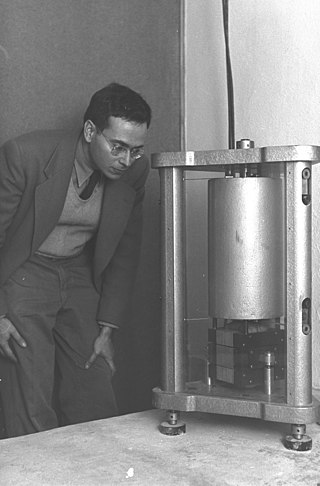
Seismology is the scientific study of earthquakes and the propagation of elastic waves through the Earth or other planetary bodies. It also includes studies of earthquake environmental effects such as tsunamis as well as diverse seismic sources such as volcanic, tectonic, glacial, fluvial, oceanic, atmospheric, and artificial processes such as explosions. A related field that uses geology to infer information regarding past earthquakes is paleoseismology. A recording of Earth motion as a function of time is called a seismogram. A seismologist is a scientist who does research in seismology.

William Maurice "Doc" Ewing was an American geophysicist and oceanographer.

Frank Press was an American geophysicist. He was an advisor to four U.S. presidents, and later served two consecutive terms as president of the U.S. National Academy of Sciences (1981–1993). He was the author of 160 scientific papers and co-author of the textbooks Earth and Understanding Earth.
Seismic moment is a quantity used by seismologists to measure the size of an earthquake. The scalar seismic moment is defined by the equation , where
The moment magnitude scale is a measure of an earthquake's magnitude based on its seismic moment. It was defined in a 1979 paper by Thomas C. Hanks and Hiroo Kanamori. Similar to the local magnitude/Richter scale (ML ) defined by Charles Francis Richter in 1935, it uses a logarithmic scale; small earthquakes have approximately the same magnitudes on both scales. Despite the difference, news media often says "Richter scale" when referring to the moment magnitude scale.

In geophysics and reflection seismology, amplitude versus offset (AVO) or amplitude variation with offset is the general term for referring to the dependency of the seismic attribute, amplitude, with the distance between the source and receiver. AVO analysis is a technique that geophysicists can execute on seismic data to determine a rock's fluid content, porosity, density or seismic velocity, shear wave information, fluid indicators.

In seismology and other areas involving elastic waves, S waves, secondary waves, or shear waves are a type of elastic wave and are one of the two main types of elastic body waves, so named because they move through the body of an object, unlike surface waves.
The Lamont–Doherty Earth Observatory (LDEO) is the scientific research center of the Columbia Climate School, and a unit of The Earth Institute at Columbia University. It focuses on climate and earth sciences and is located on a 189-acre campus in Palisades, New York, 18 miles (29 km) north of Manhattan on the Hudson River.

Keiiti Aki was a Japanese-American professor of Geophysics at the Massachusetts Institute of Technology (MIT), and then at the University of Southern California (USC), seismologist, author and mentor. He and Paul G. Richards coauthored "Quantitative Seismology: theory and methods".

Adam Marian Dziewoński was a Polish-American geophysicist who made seminal contributions to the determination of the large-scale structure of the Earth's interior and the nature of earthquakes using seismological methods. He spent most of his career at Harvard University, where he was the Frank B. Baird, Jr. Professor of Science.
Bernard A. Chouet is a geophysicist who specializes in volcanic seismology. He discovered that volcanic eruptions could be predicted by observing the frequency of certain seismic waves that are generated by volcanoes.

John "Jack" Ertle Oliver was an American scientist. Oliver, who earned his PhD at Columbia University in 1953, studied earthquakes and ultimately provided seismic evidence supporting plate tectonics. In the 1960s, Oliver and his former graduate student, Bryan Isacks, set up seismographic stations in the South Pacific to record earthquake activity, and the data collected led to the insight that part of the ocean floor was being pushed downward.
In the mathematical modeling of seismic waves, the Cagniard–De Hoop method is a sophisticated mathematical tool for solving a large class of wave and diffusive problems in horizontally layered media. The method is based on the combination of a unilateral Laplace transformation with the real-valued and positive transform parameter and the slowness field representation. It is named after Louis Cagniard and Adrianus de Hoop; Cagniard published his method in 1939, and De Hoop published an ingenious improvement on it in 1960.
Dispersive body waves is an important aspect of seismic theory. When a wave propagates through subsurface materials both energy dissipation and velocity dispersion takes place. Energy dissipation is frequency dependent and causes decreased resolution of the seismic images when recorded in seismic prospecting. The attendant dispersion is a necessary consequence of the energy dissipation and causes the high frequency waves to travel faster than the low-frequency waves. The consequence for the seismic image is a frequency dependent time-shift of the data, and so correct timings for lithological identification cannot be obtained.
Stanley Martin Flatté was a particle physicist and expert on wave propagation in atmospheric optics, ocean acoustics, and seismology.

Inner core super-rotation is the eastward rotation of the inner core of Earth relative to its mantle, for a net rotation rate that is faster than Earth as a whole. A 1995 model of Earth's dynamo predicted super-rotations of up to 3 degrees per year; the following year, this prediction was supported by observed discrepancies in the time that p-waves take to travel through the inner and outer core.
Charles Lum Drake was an American geologist who was Professor of Geology at Dartmouth College, New Hampshire.
Michel Campillo is a French seismologist and geophysicist who is currently a professor at Grenoble Alpes University.
In physics, the Weyl expansion, also known as the Weyl identity or angular spectrum expansion, expresses an outgoing spherical wave as a linear combination of plane waves. In a Cartesian coordinate system, it can be denoted as
Shamita Das is an Emeritus Professor at the University of Oxford and an Emeritus Fellow at Exeter College. She is known for her research on earthquakes, in particular the speed that earthquakes can propagate through the earth.









